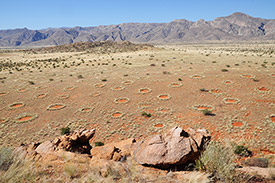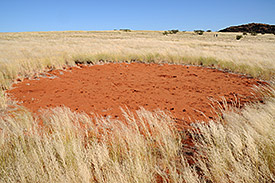Press release 20 May 2014
Fairy circles apparently not created by termites after all
New study of mysterious bare patches in Namibian grasslands supports theory of self-organisation
Leipzig. For several decades scientists have been trying to come up with an explanation for the formation of the enigmatic, vegetation-free circles frequently found in certain African grassland regions. Now researchers have tested different prevailing hypotheses as to their respective plausibility. For the first time they have carried out a detailed analysis of the spatial distribution of these fairy circles – and discovered a remarkably regular and spatially comprehensive homogenous distribution pattern. This may best be explained by way of reference to local resource-competition for water among plants and vegetation, the team now reports in the scientific journal Ecography.

Aerial view of the mysterious fairy circles of Namibia. The enigmatic, bare patches within the grassland occur in millions
at the transition to the Namib Desert. This picture was taken in the Marienfluss Valley, close to one of the study areas for which the scientists have
undertaken extensive aerial image analyses. The authors of the study have, for the first time ever, investigated the spatial patterns of the fairy circles
in detail. Typical for these patterns are the regularly spaced distances in-between circles at small neighbourhood scale while homogeneously
spread distribution prevails at large scale level. The scientists conclude from these results to have found strong support for the theory of
self-organisation, with the remarkable circle patterns emerging as a result of plant competition for water.
Photo: Dr. Stephan Getzin/UFZ

Close-up view of a fairy circle. Total absence of vegetation growth within the almost circular area of a typical fairy circle.
The sizes of fairy circles may vary, ranging from two to more than twenty metres in diameter. The average diameter recorded here, in the Marienfluss
Valley, was approx. six metres.
Photo: Dr. Stephan Getzin/UFZ
It looks like a landscape covered with freckles. Arid grassland regions in certain parts of southwest Africa are covered with barren circular patches. Some of these measure only a few metres, others reach up to twenty (20) metres in diameter; and most of them display pronounced and lush peripheral growth of grass. These so-called fairy circles virtually do extend an open invitation for speculation: What has led to the formation of these enigmatic structures?
“Although scientists have been trying to answer this question for decades their mystery remains as yet unresolved”, states Dr. Stephan Getzin from the Helmholtz Centre for Environmental Research (UFZ) in Leipzig – because up to now no one has been able to actually observe, in situ, the genesis of a fairy circle.
There are however several theories, the most popular of which hypothesises that these mysterious patches are the work of termites. The insects allegedly nibble away at the grassroots, thus causing the dieback of vegetation. Other researchers consider hydrocarbons emanating from the depths of the earth being responsible for this phenomenon. Like in a chimney, these gases are presumed to be rising to the surface resulting in the localised loss and disappearance of vegetation.
A third fraction of scientists believes self-regulating grass growth in itself being the cause, under certain circumstances, for this type of spatial patterning since it is remarkable that the occurrence of fairy circles appears to be restricted to particularly arid zones right at the transition from grassland to desert regions. This is where intense localised resource-competition for water exists among existing vegetation. If competition becomes too strong and available soil moisture resources too scarce this could lead to the emergence of bare patches with a lush peripheral grass ring formation.
Together with colleagues from Göttingen (Germany), Italy and Israel, Stephan Getzin has investigated which of these three hypotheses is most likely to be right. “We have adopted an entirely novel approach in this research”, reports this member of the UFZ institute, who by now has been studying fairy circles for more than 15 years. This study is based on the review and evaluation of aerial images, covering representative regions with fairy circle occurrences throughout northwest Namibia. With the aid of these images scientists have analysed for the first time the exact spatial location and distribution of these barren patches within the surrounding landscape: Are they arranged and positioned merely by chance – just like coins dropped accidentally and now scattered all over the place? Are there signs or distinguishable patterns of clustering in certain locations? Or do these patches perhaps need to maintain a minimum distance to their respective neighbours?
This can hardly be seen and detected with the naked eye. But statistical methodology is available to illustrate the respective distribution patterns, at different levels of scale. According to this methodology fairy circles are distributed surprisingly regular and homogenous, even across large spatial areas. “The occurrence of such patterning in nature is rather unusual” says Stephan Getzin. “There must be particularly strong regulating forces at work“.
However, in his view this rather discredits the generally popular termite theory. In a study published in the scientific journal Science (2013) the sand termite species Psammotermes allocerus was indeed presented as most likely suspect for the creation of the enigmatic barren patches – albeit primarily based on the argument, that the occurrence of this particular species of termites has been common to all fairy circles investigated at the time. No one has so far observed these creatures actually grazing holes into the Namibian grasslands – let alone in such consistent patterns. Stephan Getzin points out: “There is, up to now, not one single piece of evidence demonstrating that social insects are capable of creating homogenously distributed structures, on such a large scale”. On the contrary: The entire range of studies covering the distribution of ant and termite populations in arid territories predominantly rather attests to the occurrence of irregular, clustered distribution patterns at large scales. And, according to the research team, underground emission of abiotic gases, as well, is unlikely to result in such evenly dispersed and homogeneous spatial distribution.
What remains as probable cause is local resource-competition among plants and vegetation – which incidentally seems quite capable of creating homogeneously scattered circles. Whereas, for example, in a young-growth forest plants will grow and develop at comparatively close range, vegetation will thin out and regress, over the years, in a self-organising process. Each mature tree, after all, needs sufficient space and nutrition for its development and will therefore be able to survive only at an appropriate distance to its neighbour. A similar process of resource-competition may consequently also be the real cause for a self-organising formation of the mysterious fairy circle patterns.
Using a computer model Stephan Getzin and his colleagues from Israel, who are specialised in this type of processing techniques, have simulated belowground competition for water and the resulting spatial vegetation distribution patterns – and very similar patterns indeed emerged on the screen, akin to the images recorded in Namibia. And in the course of all statistical review and analysis performed, the characteristics of simulated and real fairy circles turned out to be remarkably congruent and close to identical. For the UFZ researchers this represents compelling evidence, that the enigmatic patches may in fact be the result of spatially self-organising grass growth. “We consider this at present being the most convincing explanation“.
Publication
Stephan Getzin, Kerstin Wiegand, Thorsten Wiegand, Hezi Yizhaq, Jost von Hardenberg, Ehud Meron:
Adopting a spatially explicit perspective to study the mysterious fairy circles of Namibia. Ecography 2014
Early View, 20 MAY 2014. DOI: 10.1111/ecog.00911
http://onlinelibrary.wiley.com/doi/10.1111/ecog.00911/abstract
Further information
Dr. Stephan Getzin
Helmholtz Centre for Environmental Research (UFZ)
Telephone +49 (0)341 235 1719
Dr. Stephan Getzin
or
Tilo Arnhold, Susanne Hufe (UFZ Press office)
Telephone: +49 (0)341 235-1635, -1630
Further link
New methods for modelling systems in a changing world
www.ufz.de/index.php?de=17617
At the Helmholtz Centre for Environmental Research (UFZ) scientists are interested in the wide-ranging causes and impacts of environmental change. They conduct research on water resources, biodiversity, the impacts of climate change and adaptation strategies, environmental and biotechnologies, bioenergy, the behaviour of chemicals in the environment and their effects on health, modelling and sociological issues. Their guiding motto: our research serves the sustainable use of natural resources and helps towards long-term food and livelihood security in the face of global change. The UFZ has over 1,100 employees working in Leipzig, Halle und Magdeburg. It is funded by the federal government, as well as by the State of Saxony and Saxony Anhalt.
The Helmholtz Association contributes to finding solutions for large and pressing issues in society, science and the economy through excellence in the following six areas of research: energy, earth and the environment, health, key technologies, structure of matter, transport and aerospace. With almost 36,000 employees and coworkers in 18 research centres and an annual budget of approx. 3.8 billion Euros the Helmholtz Association is the largest scientific organization in Germany. Work is conducted in the tradition of the renowned natural scientist Hermann von Helmholtz (1821-1894).
